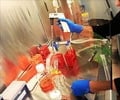Clinical Features of Leishmaniasis (Kala-Azar)
Cutaneous leishmaniasis (Kala-azar) produces chronic, localized skin lesions. Massively enlarged spleen and liver are hallmarks of a classic case of visceral leishmaniasis.
The symptoms and signs depends on the type of manifestation of leishmaniasis that is manifested in the patient.
Cutaneous leishmaniasis (Kala-azar)
Cutaneous leishmaniasis produces chronic, localized skin lesions.
- Lesions may be single or multiple.
- Size and appearance of these sores change over time and eventually ulcerate.
- Ulcerated lesions are generally they are not painful.
- A scab may cover the ulcer
The lesions persist for a time defined by the species of parasite involved; it can months or years. Features like regional lymphadenopathy (i.e. swollen glands near the lesion), fever, and constitutional symptoms may precede the appearance of lesions in some cases.
Visceral leishmaniasis (Kala-azar)
Visceral leishmaniasis produces:
- Fever,
- Malaise,
- Anorexia,
- Weight loss,
- Enlargement of the abdomen due to massively enlarged spleen and liver are hallmarks of a classic case of visceral leishmaniasis.
In some geographical areas lymphadenopathy is common. A chronic disease produces significant weight loss. Advanced, life-threatening disease is called kala-azar [means black {kala} fever {azar} in Hindi]. In spite of the name, darkening of the skin is not common.
About 5 to 10% of persons treated for visceral leishmaniasis in India develop Post–kala-azar dermal leishmaniasis (PKDL). Here lesions appear about 2 years after treatment and may persist for up to 20 years.
Visceral leishmaniasis is an important opportunistic disease in persons with acquired immunodeficiency syndrome (AIDS).
Mucosal leishmaniasis (Kala-azar)
Mucosal leishmaniasis usually begins with unusual nasal symptoms like bleeding (epistaxis) and stuffiness. The mucosa of the nose gets reddened (erythematous) and oedematous. Ulcerative destruction soon follows. The back of the mouth (the oropharynx) also gets involved.







